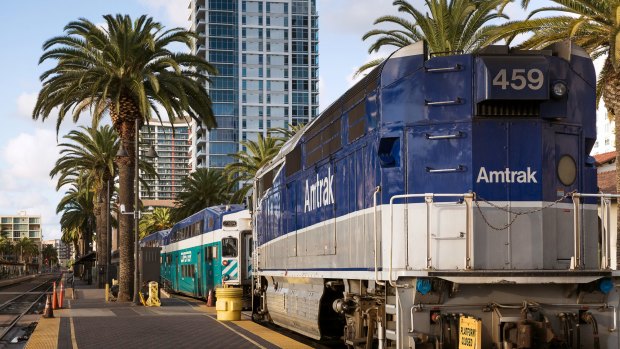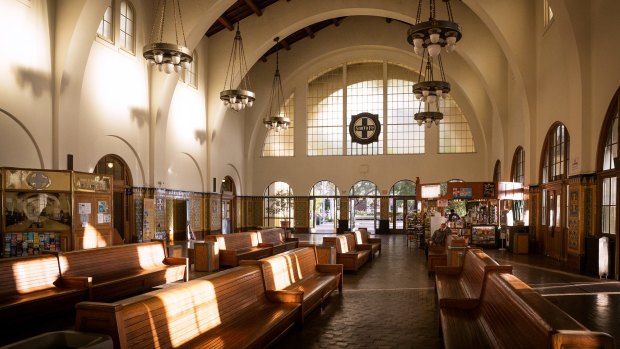This was published 6 years ago
The Pacific Surfliner train along the Pacific Coast from Los Angeles to San Diego
By Shaney Hudson

The Pacific Surfliner has seen passenger numbers grow significantly as more people become aware of the pleasures of the picturesque seaside route, with the Surfliner emerging as Amtrak's third busiest route.
San Diego might have been our final destination, but after a long flight from Sydney, we just wanted an easy escape from LA. Planning ahead, flights were expensive, connections were lengthy and the thought of negotiating the LA freeways in a hire car after a long haul left us cold.
If we'd been anywhere else in the world, taking a train would have been our go-to option. There's something dignified about train travel: an opportunity to get lost in the landscape, a good book, or at the very least, a chance to knock some work over. But in the gas guzzling, car-loving US, there didn't seem to be any room for the sentimentality of train travel.
Luckily, a two-for-one ticket special on a train called the Pacific Surfliner caught our eye, and unexpectedly, what began as a means of getting from A to B turned out to be the perfect start to our Californian getaway.

The Pacific Surfliner to San Diego Santa Fe Station.
Amtrak's Pacific Surfliner runs from San Luis Obispo to San Diego, a 560-kilometre journey that takes just under six hours. Using a FlyAway shuttle to transfer from LAX, we join the train at Union Station in Los Angeles.
Listed on the National Register of Historic Places, Los Angeles Union Station opened in 1939 during the golden age of train travel. Although we enter from the back bus depot, it's an architectural buffet of period styles: there are elements of art deco, Spanish Mission Revival and streamline modern styles, soaring painted ceilings with intricate wooden beams, marble floors and gothic modern signage.
There's also the obligatory Starbucks. Coffee safely in hand, we hit a wall when we discover our 11am train has been cancelled. Luckily, the slight hiccup works in our favour, with our pre-booked tickets now valid for any journey that day. We opt to take the next train down the coast: the 5066 southbound service.

San Diego Santa Fe Station.
On the platform, the purpose-built, double decker blue and silver carriages are some of the biggest I've seen. There are racks for surfboards and bikes downstairs, with lower level seating reserved for senior citizens and disabled passengers.
On board, a conductor in an old-fashioned uniform and shiny gold and black felt cap checks our tickets. Seeing our open guidebook, luggage and jet-lagged induced state, he rightly assumes we're clueless about the journey ahead.
"San Diego eh?" he gruffs.
"Yes," I reply nervously, sure I've managed to mess the online ticket purchase up. He hikes his thumb towards the opposite row of seats.
"View's on the other side". We shuffle over as the train pulls out of the station.
Train travel has always had its devotees, those who prefer the patience of the journey and presence of the landscape to the convenience of other means of travel. However, the Pacific Surfliner has seen passenger numbers grow significantly as more people become aware of the pleasures of the picturesque seaside route, with the Surfliner emerging as Amtrak's third busiest route.
That said, as the train weaves through Los Angeles, it's hard to see how this qualifies as the scenic route. Grim and industrial, the train passes over concrete canals and under multi-lane freeways that swallow the sun. There are, however, little hints that we are have arrived in Los Angeles: American flags adorning every flagpole, a film set bustling in the empty parking lot of Anaheim's Angel Stadium, and palm trees peering over the rooftops as if they're trying to see if the coast is clear to make a getaway.
Even though we're in economy, seats are comfortable with ample legroom, spacious seating, wide windows and free wifi. Peeking into Business Class, we can't discern much difference in fare, although there is a stash of free snacks available including tetra packs of juice and plastic-wrapped muffins.
As we reach Santa Ana, there's a softening of the landscape and and the catharsis of train travel begins to kick in, the gentle rocking of the locomotive across the tracks a welcome juxtaposition to the gut-wrenching turbulence of the previous evening's flight.
And then the landscape unfurls: one moment I'm in suburbia, watching the distant barren hills, the next the train is running along a stretch of beach. The Pacific Ocean shimmers in the morning light, dotted with long boarders and seagulls. Save for the empty lifeguard towers and joggers, the golden sands are empty, the waves gently washing the shore.
The train stops for a few minutes at San Clemente Pier. From inside the train, I quietly observe the Sunday morning rituals of those who live along this stretch of beach. Surfers catch the latest set off the pier break, fisherman drop a line off the pylons, staff unpack chairs at seaside restaurants, kids play on swings and people walk dogs, happily enjoying their day; a satisfying first taste of SoCal beach culture.
At times the Surfliner runs level with the sea, at others high on the cliffs. The track winds through fishing ports and yacht harbours, holiday condos and swampy marshland, passing through surf towns that read like the lyrics of a Beach Boys song: Encinitas and Del Mar, Solano and Oceanside, until the train begins to fall back behind the Interstate 5 and Torrey Pines State Natural Reserve, curling towards San Diego.
Our journey ends at San Diego's Santa Fe station, where vines of purple bougainvillea frame the street level platforms. Over a hundred years old, the Spanish-designed station is smaller than Union Square, but fits the border town perfectly: with its wide-arched roof, black metalwork lamps, church pew benches and detailed tile work in shades of green, yellow and blue.
It's been a satisfying and mellow journey, one that sets the tone for the rest of our time in California. And inspired by taking the scenic route, we forgo a planned cab ride to our hotel in Coronado Island, instead opting to take the old ferry across the harbour. As our journey had proved, sometimes the old-fashioned ways of travel are best.
TRIP NOTES
MORE
TRAVEL
Virgin Australia fly from Sydney to Los Angeles with fares from $1053AUD. See virginaustralia.com or phone 13 67 89
The FlyAway shuttle bus runs from LAX to Union Station with regular departures seven days a week for $9.75USD one way. See lawa.org/FlyAway
The Pacific Surfliner connects Los Angeles with San Diego; unreserved coach seats cost from $37USD ($47AUD). See pacificsurfliner.com or amtrak.com
STAY
The 14-room Scripps Inn overlooks the ocean at La Jolla with rooms from $265USD ($335AUD) See scrippsinn.com
Shaney Hudson travelled with the assistance of the San Diego Tourism Authority.
See also: How to travel around Australia without boarding a plane
Sign up for the Traveller Deals newsletter
Get exclusive travel deals delivered straight to your inbox. Sign up now.